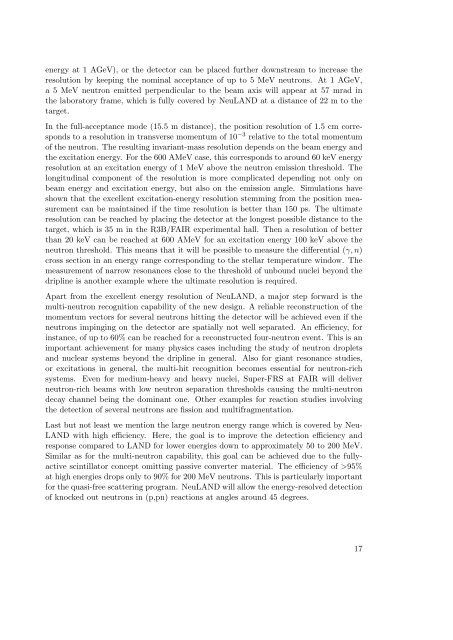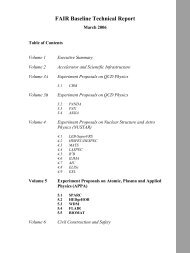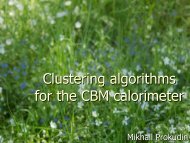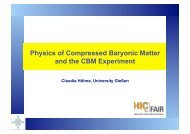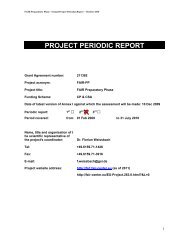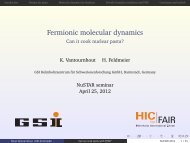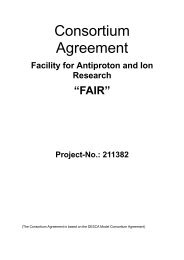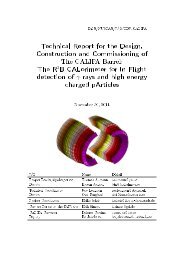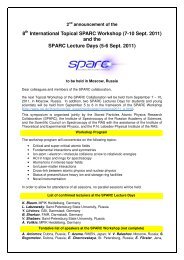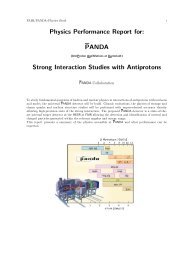NeuLAND - FAIR
NeuLAND - FAIR
NeuLAND - FAIR
Create successful ePaper yourself
Turn your PDF publications into a flip-book with our unique Google optimized e-Paper software.
energy at 1 AGeV), or the detector can be placed further downstream to increase the<br />
resolution by keeping the nominal acceptance of up to 5 MeV neutrons. At 1 AGeV,<br />
a 5 MeV neutron emitted perpendicular to the beam axis will appear at 57 mrad in<br />
the laboratory frame, which is fully covered by <strong>NeuLAND</strong> at a distance of 22 m to the<br />
target.<br />
In the full-acceptance mode (15.5 m distance), the position resolution of 1.5 cm corresponds<br />
to a resolution in transverse momentum of 10 −3 relative to the total momentum<br />
of the neutron. The resulting invariant-mass resolution depends on the beam energy and<br />
the excitation energy. For the 600 AMeV case, this corresponds to around 60 keV energy<br />
resolution at an excitation energy of 1 MeV above the neutron emission threshold. The<br />
longitudinal component of the resolution is more complicated depending not only on<br />
beam energy and excitation energy, but also on the emission angle. Simulations have<br />
shown that the excellent excitation-energy resolution stemming from the position measurement<br />
can be maintained if the time resolution is better than 150 ps. The ultimate<br />
resolution can be reached by placing the detector at the longest possible distance to the<br />
target, which is 35 m in the R3B/<strong>FAIR</strong> experimental hall. Then a resolution of better<br />
than 20 keV can be reached at 600 AMeV for an excitation energy 100 keV above the<br />
neutron threshold. This means that it will be possible to measure the differential (γ, n)<br />
cross section in an energy range corresponding to the stellar temperature window. The<br />
measurement of narrow resonances close to the threshold of unbound nuclei beyond the<br />
dripline is another example where the ultimate resolution is required.<br />
Apart from the excellent energy resolution of <strong>NeuLAND</strong>, a major step forward is the<br />
multi-neutron recognition capability of the new design. A reliable reconstruction of the<br />
momentum vectors for several neutrons hitting the detector will be achieved even if the<br />
neutrons impinging on the detector are spatially not well separated. An efficiency, for<br />
instance, of up to 60% can be reached for a reconstructed four-neutron event. This is an<br />
important achievement for many physics cases including the study of neutron droplets<br />
and nuclear systems beyond the dripline in general. Also for giant resonance studies,<br />
or excitations in general, the multi-hit recognition becomes essential for neutron-rich<br />
systems. Even for medium-heavy and heavy nuclei, Super-FRS at <strong>FAIR</strong> will deliver<br />
neutron-rich beams with low neutron separation thresholds causing the multi-neutron<br />
decay channel being the dominant one. Other examples for reaction studies involving<br />
the detection of several neutrons are fission and multifragmentation.<br />
Last but not least we mention the large neutron energy range which is covered by Neu-<br />
LAND with high efficiency. Here, the goal is to improve the detection efficiency and<br />
response compared to LAND for lower energies down to approximately 50 to 200 MeV.<br />
Similar as for the multi-neutron capability, this goal can be achieved due to the fullyactive<br />
scintillator concept omitting passive converter material. The efficiency of >95%<br />
at high energies drops only to 90% for 200 MeV neutrons. This is particularly important<br />
for the quasi-free scattering program. <strong>NeuLAND</strong> will allow the energy-resolved detection<br />
of knocked out neutrons in (p,pn) reactions at angles around 45 degrees.<br />
17


